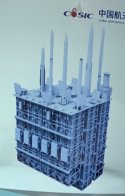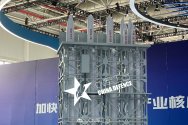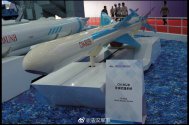How possible is it to convert something like the YJ83 onto a VLS? If I'm not wrong its just under 7mIf they go with an amidships UVLS bank instead of slant launched AShMs, I think it would have to be the 9m variant to allow them to launch AShMs (unless they develop a new, shorter AShM).
You are using an out of date browser. It may not display this or other websites correctly.
You should upgrade or use an alternative browser.
You should upgrade or use an alternative browser.
054B/new generation frigate
- Thread starter Blitzo
- Start date
How possible is it to convert something like the YJ83 onto a VLS? If I'm not wrong its just under 7m
Check the missile with the canted nose. Its either meant to represent a modified YJ-83B with the infrared imaging seeker, given taht there is no other missile in Chinese service that's like this, or something similar to it. Its also poking out of the first section, which is the 7 meter. The second and third sections are 9 meters, where you can see the two stage missile.

How possible is it to convert something like the YJ83 onto a VLS? If I'm not wrong its just under 7m
Not impossible, and the VLS shown at Zhuhai last year depicted the export CM-802B (export variant of dual mode YJ-83 with canted nose), but we have no evidence and no rumours that the PLAN are pursuing a vertical launched YJ-83 variant for their own use.


Can they launch the YU-8 via the UVLS? I've only seen it launch from the Type 054A VLS. If the Type 054B is going to be ASW focused it should have some sort of ASROC.
We expect Yu-8 or another ASROC type weapon to be integrated with the UVLS, yes.
Check the missile with the canted nose. Its either meant to represent a modified YJ-83B with the infrared imaging seeker, given taht there is no other missile in Chinese service that's like this, or something similar to it. Its also poking out of the first section, which is the 7 meter. The second and third sections are 9 meters, where you can see the two stage missile.
View attachment 88106
I should add that these canted nose missile, supposedly a digital IIR seeker, isn't just for antiship but for precision attack on land targets which is right now, a large gap in the PLAN's capabilities, although I don't know or not, if this capability was deliberately left out for the land based rocket and cruise missile forces. The use of precision land attack missiles by the PLAN would mark a major change in their doctrine, and in my view, a much needed one.
They can begin to use such either with a brand new airframe or an existing airframe like the YJ-83B, which would undoubtedly be cheaper and heavily shortcut the development process. I would think that using a VLS YJ-83B, even with an expanded booster, might still fit within the 7 meter maximum requirement of the smaller U-VLS canister, which allows for more available cells to be used.
Going back to antiship missiles, I do not think it is absolutely necessary for them to be VLS'ed unless you absolutely need and want to use the YJ-18. Deck mounted slanted canisters have their advantages. You can save the space below deck for something else, and you can change the slanted canisters and stands easily for something else. For certain ships, they can be added, like having 8 launchers in peacetime, but there is enough deck space to add 8 more during wartime. The canisters can be made shorter, and the missiles shorter and lighter. If a slanted canister is used on deck, you would have to use the YJ-83 or YJ-12 missile. A stealthy LRASM equivalent can use both slant and vertical launch. The advantage of a slant launch is that your booster does not need to be as big, so there is savings in weight and size. While the advantages are minor, ship space and weight is like wringing water out of a moist towel, you want every little bit of it from the little you are given. I also think the YJ-83 can be potentially VLS'ed if so desired, so the real question of choosing slant vs. VLS is going to reflect on another issue, the slant mounted YJ-12 vs. the VLS'ed YJ-18. Which is the better missile and which would you prefer ultimately?
The advantage of using IIR antiship missiles is to deal with stealthy combatant ships in the littoral zones where there is plenty of clutter from rocks, islands, and things beneath waves. Antiship missiles with radar guidance, which includes typically like your YJ-12, YJ-18 and earlier YJ-83 would have problems on such. Hence the use of the IIR seeker YJ-83B would fill this gap, and is an important capability among smaller and intermediate ship combatants, like 022, 056A and so on. That also makes sense for it to be added on the 054B's tool kit, whether it is the YJ-83B, or some equivalent successor.
Last edited:
I could totally see the PLA adopting a new VLS ashm based on a stealthed YJ-83, since not every ship needs as long range/advanced/expensive of a missile as the YJ-18, not to mention it's easier to fit 7m uvls on a frigate
Yes, I think a vertically launched stealthy ashm (with secondary land attack role) designed to fit the 7m UVLS, would fill a rather major capability gap.
It could also have an air launched variant to replace the YJ-83K and KD-88 both.
Alas, this is part of a broader discussion about the future of PLA ashms and LACMs that we can only speculate about and is better discussed elsewhere
Is the third missile from the right in the back-most row of this picture the ballistic anti-ship missile being talked about recently?Check the missile with the canted nose. Its either meant to represent a modified YJ-83B with the infrared imaging seeker, given taht there is no other missile in Chinese service that's like this, or something similar to it. Its also poking out of the first section, which is the 7 meter. The second and third sections are 9 meters, where you can see the two stage missile.
View attachment 88106
I don't know if it needs to be based on YJ-83/KD-88, but I wonder about this. YJ-83 is 360mm in diameter. If ESSM at around 250 mm diameter can quad pack into MK-41, can we see quad packing of a new Chinese LO RCS subsonic AShM that's about 350mm in diameter and about 6.5 to 7m long? That would be quite a lot of fire power.
